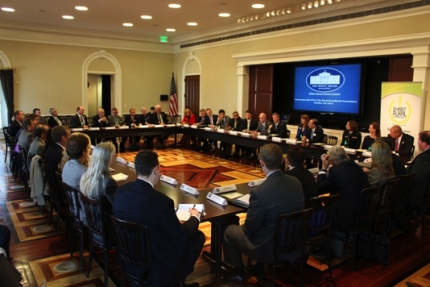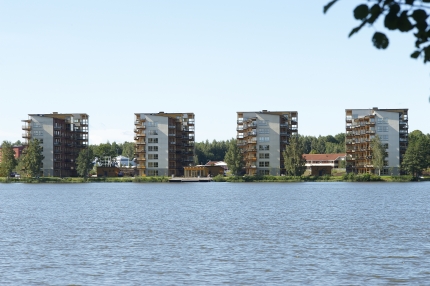Related Rural Blog Posts
2014: A Year of Action, Partnership, and Innovation at USDA
Posted by on December 23, 2014 at 12:48 PM EDTEd. note: This is cross-posted on the U.S. Department of Agriculture's blog. See the original post here.

This has been a tremendous year for the U.S. Department of Agriculture and the rural families and communities we serve.
Deputy Secretary Krysta Harden recently shared a reflection on her most inspirational moments this year. I’m proud of what we’ve accomplished at USDA over the course of this year, and I thought I’d take a moment to share just a few of our top accomplishments.
Learn more about RuralLocal Food, Local Places: Bringing Expertise and Creative Thinking to Community Economic Development
Posted by on December 3, 2014 at 11:16 AM EDTAround the country, communities are seeking creative approaches to integrating entrepreneurship, environmental management, public health, and other place-based considerations into successful economic planning. Local food development can be one strategy.
The White House Rural Council and six federal agencies have selected 26 communities to participate in Local Foods, Local Places, a federal initiative providing direct technical support and expertise to community partners integrating local food systems into regional economic action plans. Under this effort, a team of federal agricultural, transportation, environmental, public health, and regional economic experts will work directly with communities to develop specific local food projects. These efforts will make a significant impact in the communities participating in the Local Foods, Local Places initiative.
Learn more about RuralPromoting Rural Opportunity by Expanding Access to Broadband
Posted by on October 31, 2014 at 9:47 AM EDTPresident Obama has made expanding broadband access a key priority throughout his Administration. He launched the ConnectED Initiative in June 2013, ensuring that 99% of our students will have high-speed broadband in their classrooms by 2017 and that broadband infrastructure will reach rural areas. The White House Rural Council has supported these efforts to expand access to affordable broadband networks to support community benefits such as education, health care, and job creation.
Just this week, the White House Rural Council hosted a dialogue with members of the NTCA - The Rural Broadband Association. NTCA members are rural, independent, telecommunication companies from across America. NTCA advocates on behalf of these companies to ensure that they can drive innovation and deliver service throughout rural America. Our dialogue was focused on NTCA’s Smart Rural Community initiative, which recognizes a small selection of NTCA members who are exceptionally serving their communities by using their broadband systems to improve health care infrastructure, education, government services, among other needs.
Learn more about RuralWhat USDA Did This Week to Help Rural America:
Posted by on October 24, 2014 at 2:09 PM EDTThis post is the first in a new series that will highlight the work happening across the President's cabinet on any given week. Check back each week -- we guarantee you'll learn something that surprises you.

Those of us who call rural America home know that there’s more to the rural economy than just farms and ranches. From bio-based products to rural manufacturing, the potential to grow and make innovative products in rural America is limitless. Most rural businesses are small ones -- and they support one in three jobs in rural America. Our loans and grants are helping those businesses thrive -- supporting reliable services like water, housing and broadband to make these same communities attract and retain a talented workforce. Collectively, these investments support the businesses and families that call America’s rural areas “home.” That's because we know that the better we equip those communities with the resources they need to succeed, the stronger our entire country's economy will be as a result.
I'm proud to report that the Department of Agriculture did several really important things to help rural communities across the country this week. Here's a run down on what we've been up to. Take a look, and if you learned something new -- pass it on.
Want to stay up to date with USDA? Follow along with us on Twitter at @USDA.
Women Are the Past, Present, and Future of American Agriculture
Posted by on October 17, 2014 at 2:20 PM EDTFrom historic homesteaders to contemporary cattle ranchers, women have been the cornerstone of America’s agriculture heritage. We’ve produced food to feed our families, feed our neighbors, and to feed the world.
The 2012 Census of Agriculture notes that nearly 1 million women are working America’s lands. That’s nearly a third of our nation’s farmers. These women are generating $12.9 billion in annual agricultural sales.
Farm work isn’t the only way women are contributing to agriculture. We are scientists, economists, foresters, veterinarians, and conservationists. We are in the boardrooms and the corner offices of international enterprises, and are the owners and operators of small businesses. We are property owners and managers. We are policymakers and standard bearers. Women are increasingly involved in every aspect of agriculture.
Learn more about RuralAnnouncing the U.S. Tall Wood Building Prize Competition to Innovate Building Construction
Posted by on October 10, 2014 at 10:46 AM EDTAs part of the Obama administration's commitment to mitigate climate change, USDA, in partnership with the Softwood Lumber Board and the Binational Softwood Lumber Council, is announcing the U.S. Tall Wood Building Prize Competition. This competitive prize, open to teams of architects, engineers, and developers, will showcase the architectural and commercial viability of advanced wood products like Cross Laminated Timber (CLT) in tall buildings.
Advanced wood products are becoming the latest innovation in tall building construction. Products like CLT are flexible, strong, and fire resistant. In construction, wood products can be used as a successful and sustainable alternative to concrete, masonry, and steel. Using wood also reduces greenhouse gas emissions by storing carbon and simultaneously offsetting emissions from conventional building materials. By some estimates, the near term use of CLT and other emerging wood technologies in buildings 7-15 stories could have the same emissions control affect as taking more than 2 million cars off the road for one year.
Learn more about Rural
- &lsaquo previous
- 1
- 2
- 3
- 4
- 5
- 6
- 7
- 8
- 9
- …
- next &rsaquo

